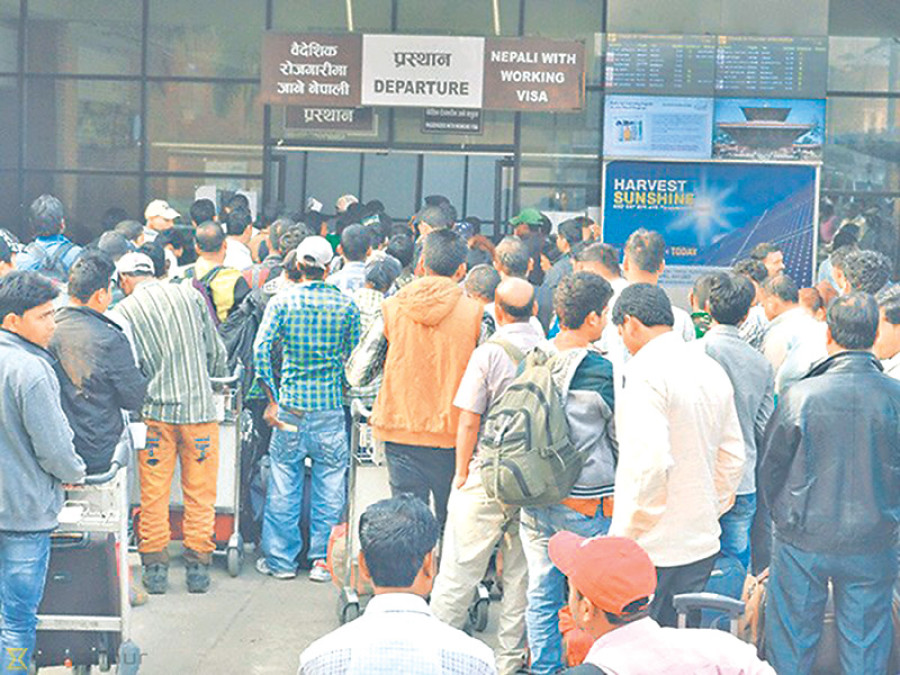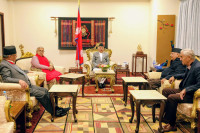Opinion
Value of life
With tearful eyes Rama from Nawalparasi district shares “My husband’s contractual period in Malaysia was coming to an end.
Roni Pradhan
With tearful eyes Rama from Nawalparasi district shares “My husband’s contractual period in Malaysia was coming to an end. My daughter Nisha and I were counting the days till he could come back to Nepal and we could meet again. But a few days before his departure, he died in a road accident. Our dreams were shattered. Nisha had only spoken to him over the phone and had never seen him as he had left for Malaysia when she was 13 days old. At the age of 20, I lost my husband.”
The Foreign Employment Promotion Board (FEPB) data shows that 4,322 Nepalis have died in 24 different destination countries from 2008/09 to 2014/15. Pravasi Nepali Coordination Committee (PNCC), an organisation that works for migrants’ rights, received 305 death cases (98 percent men) of Nepali migrants from 52 districts of Nepal for the period between January 1, 2015 and July 31, 2016. Analysis of these documented cases reveals that 85 percent of these migrants were married, most with two or more children. The deaths had occurred in Saudi Arabia (42 percent), Malaysia (36 percent), Qatar (13 percent), UAE (4 percent), Kuwait (2 percent), and other countries (3 percent). The most common cause of death among Nepali migrants was “natural death”, which accounted for 64 percent, followed by traffic accidents (15 percent), workplace accidents (14 percent), suicide (6 percent) and murder (1 percent). The data reveals that 27 percent of the cases were between 25 and 29 years of age, whereas, 20 percent belonged to the 30-34 age group, and 21 percent to the 35-39 age group. It is worrying that young Nepali migrants in their most productive years are dying in destination countries. Why are Nepali migrants who were proven to be medically fit before departure dying in large numbers at such a young age?
Initiatives to be taken
Mandatory insurance for migrants, financial assistance (Rs 700,000) from FEPB in the case of the death of documented migrants, scholarship for the children of the deceased and fully disabled migrants, and free transportation of the remains from Tribhuvan International Airport to the migrants’ districts are some of the good practices currently implemented which should be commended. However, what is lacking is more intervention in preventive measures. The high number of migrant deaths needs special attention and plans from various stakeholders. Diplomatic missions in the destination countries should be strengthened in terms of human and financial resources for rapid response mechanisms. Better living and working conditions, ethical recruitment practices, protection of migrant rights, timely accessible healthcare including psychosocial counselling services, speedy repatriation of the remains, and efficient compensation procedures are issues that Nepal needs to address in various regional and international forums like the Colombo Process, Abu Dhabi Dialogue, Global Forum for Migration and Development (GFMD), Global Compact on Migration (GCM), and during bilateral agreements with destination countries.
Living and working conditions have a strong impact on the migrants’ health. Therefore, it is crucial that more focus be given to monitoring living and working conditions. Migrant workers from South Asian countries including Nepal have contributed to the construction of giant buildings, lavish shopping malls, hospitals, stadiums, and roads in the Middle East and other countries, leading towards their economic growth and prosperity. Hence, it is the responsibility of such receiving countries to properly orient the migrants about the occupational health and safety measures in a language that is understood by the migrants. Due to a lack of knowledge regarding the language of destination countries, migrants find it difficult to complain or express their concerns related to work and working conditions. Hence, it is important for employers to have Nepali speaking persons at the management level so they are able to understand their workers’ concerns.
Reducing preventable deaths
Minimising preventable deaths and promoting the safety and rights of migrants and their families is the responsibility of both sending and receiving countries. Strong coordination between multiple stakeholders, i.e. governments, development partners and the private sectors both in the country of origin and destination is needed in order to mitigate deaths. Implementation of national, regional and international migrant’s rights instruments is crucial. More in-depth research on the subject of migrants’ death has to be carried out as it is essential to understand the core reasons behind the high rate of Nepali migrant’s deaths. The research should recommend concrete actions and programmes for the prevention of deaths from both the country of origin and country of destination. There is no doubt that foreign employment has brought benefits, not only to migrants and their families, but also to the countries of labour origin and destination. However, the huge social costs cannot be overlooked. Such tragedies can be reduced if a coordinated effort is taken involving all stakeholder nations.
Pradhan is a Senior Program Officer at Safer Migration Project (SaMi)/HELVETAS Swiss Intercooperation Nepal




 9.12°C Kathmandu
9.12°C Kathmandu











